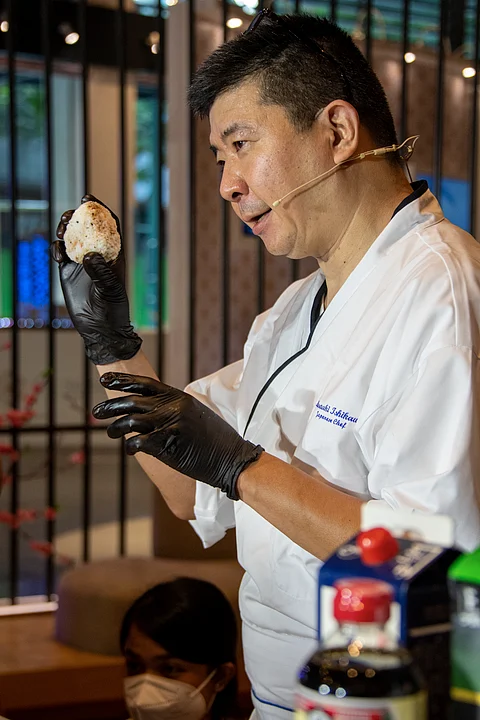

We often think that making Japanese food is best left to the experts, but there are many easy recipes that Filipinos can prepare at home using authentic Japanese ingredients that are locally available.
The Japan External Trade Organization, or JETRO, aims to make this known through an event series that will provide consumers and business owners with a deeper understanding of Japanese food ingredients.
The first event, "Bring Home a Taste of Japan," was held on 5 October, at The Seasons Residences Showroom in BGC. It showcased some of the finest food products from the Land of the Rising Sun through a cooking demonstration with chef Masaaki Ishikawa.
Chef Ishikawa ran his own restaurants in Japan for 10 years, followed by stints at Hotel Okura Manila and Sofitel Manila. He now shares his expertise in menu development and opening a restaurant with aspiring Japanese restaurant owners.

At the event, he demonstrated how easy it is to create Japanese dishes in the comfort of your own kitchen using authentic ingredients from Japan. First, he made Kani Salad with Ozaki Kani Sticks, Ozaki Japanese Mayonnaise, and Ozaki tobiko. Ozaki tobiko is that bright orange flying fish roe we often see on our sushi, and its crunchy yet soft texture goes perfectly with rich, creamy Japanese mayonnaise.
Then chef Ishikawa demonstrated the trick to making Tamagoyaki or rolled omelets. One of Tamagoyaki's unique ingredients is Futaba Shiro Dashi, or white soup stock. IThis seasoning enhances the natural flavor and color of cooking ingredients and goes wonderfully with egg dishes.
Next on the menu was Onigiri, made with Mitsukoshi Katsuo Furikake and Ozaki Nori Sheets. Furikake comes in all sorts of flavors, and Katsuo Furikake is made from bonito flakes.
Then he prepared Temari Sushi — bite-sized, ball-shaped sushi with salmon, Ozaki Kani, and hamachi fillings.
The Temari Sushi was served with Ozaki Wasabi, which can be used not only for sushi, but as a flavoring for soba, udon, and other noodle dishes. You can also add it to steak, seafood salad, and dim sum for a Japanese twist!
Afterwards, he created Salmon Rolls garnished with Mitsukoshi Sesame Dressing, Katagi Sesame Seeds, and S&B Togarashi Shichimi Chili Powder. Togarashi Shichimi is a traditional Japanese seasoning made from seven spices. S&B's chili powder features the rich aroma of red chili pepper, orange peel, black sesame, white sesame, Japanese pepper, ginger, and seaweed. It can be used for anything from noodles to fish and meat dishes.
The guests enjoyed Cold Somen Noodles, made using Jinenjo Somen Noodles with Yamasa Somen Sauce and sprinkled with Katagi Sesame Seeds. Yamasa Somen sauce is made from Yaizu bonito flakes, Hokkaido kelp dashi stock, and aged maple. This combination produces a deep flavor that is perfect for somen.
We may be familiar with black sesame seeds, but white sesame seeds are milder and sweeter in comparison. Their nutty, rich flavors make them a great topping for baked goods, pastries, salads, and even sushi.
No feast is complete without drinks, and guests sipped on cocktails made with some of the finest shochu Japan has to offer, as well as beer and other drinks. In line with its efforts to promote Japanese food and ingredients, JETRO also launched the Japanese Food Supporter program. Restaurants that serve Japanese dishes prepared using ingredients sourced from Japan and retail stores that sell Japanese food products can apply for certification as Japanese Food Supporters.
All the ingredients, condiments, and drinks highlighted in this event will be available at Mitsukoshi fresh. With the highly-anticipated opening of this supermarket, it's easier than ever to obtain authentic ingredients and bring home a taste of Japan.
